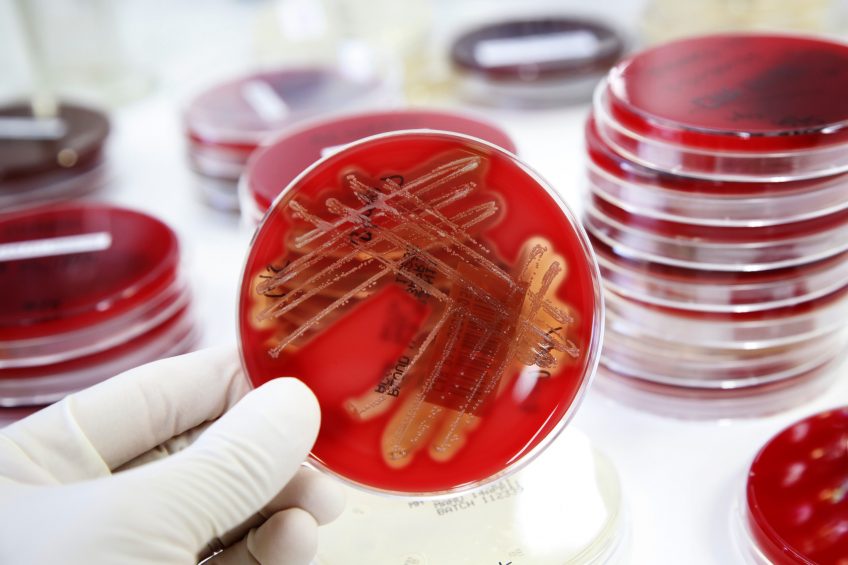Inhibiting gram-positive bacteria

Medium-chain fatty acids (MCFAs) and their derivatives are known for their pronounced antibacterial effects against gram-positive bacteria. However, it is only possible to achieve synergistic effects through a targeted combination of the active ingredients. A recent in vitro study demonstrated the influence of various MCFAs on the growth of swine-specific pathogenic germs.
Bacteria are the cause of many problems on pig farms. Infections with Streptococci are considered to be a prime reason for the high use of antibiotics in piglet production. The bacteria that are dangerous for pigs are called Streptococcus suis (S. suis). Piglets are generally infected already during or shortly after birth, with germs capable of entering the animal through even the tiniest wounds. The special feature of the dangerous Streptococci strain is that they possess the ability to enter the bloodstream, where they settle in certain places in the body via the blood and reproduce. Once the pathogen has settled in the animal, it can cause a wide variety of disease patterns. Alongside pneumonia, inflammation of the joints and meningitis, Streptococci can also lead to sudden death. The aim must therefore be to minimise the germ pressure as early and as far as possible.
Use and effect of MCFAs
Medium-chain fatty acids are particularly important in animal nutrition due to their energy supplying ingredients and antibacterial effect. Due to these properties they are highly interesting for use in pig farming. The pressure of infection on the animals, triggered by swine-specific pathogenic germs, is one of the main reasons for using antibiotic medications. Many in vitro studies displayed pronounced antibacterial effects following the use of medium-chain fatty acids against both gram-negative and gram-positive germs. Lauric acid and glycerol monolaurate are considered to be particularly active antibacterial ingredients.
The antimicrobial potential of medium chain fatty acids described in literature has already been applied in practice. Many different additives are already being used in pig feeding. Here it is important to reinforce the immunity of the animals and at the same time reduce the use of antibiotics. The fields of application and the effect of the respective acids vary widely, however, so that synergistic effects can be created by targeted selection and combination of acids.
The influence of different fatty acids on the development of swine-specific pathogenic germs was examined in an in vitro analysis. The objective of this study was to use the results to identify an efficient combination of active ingredients that effectively inhibit germ growth. The influence of the fatty acids (C12, C14, C8, C10), of the combination product, Bewi-Fatrix SynerG+ which is based on Lauric acid and plant extracts (see below), and of 2 further combination products (1 and 2) on the growth of Escherichia coli, Streptococcus suis, Salmonella poona and Clostridium perfringens was investigated. The different bacterial strains were incubated in the presence of different concentrations of the said active ingredients in a nutrient medium. Over a 15-hour period the bacterial growth was measured photometrically every hour through the absorption at a wavelength of 600nm. The results were evaluated via the data of the minimal inhibitory concentration 50 (MIC50).
Results in vitro
The active ingredients C12 and C14 exhibit a distinct influence on the bacterial growth. Bacterial growth declines with increasing concentration of these active ingredients. In comparison with the two combination products 1 and 2, it became apparent that the addition of the product to the nutrient medium inhibits the growth of gram-positive germs by 50% already at lower concentrations. Just 0.1% of the product is sufficient to reduce the germ growth of Streptococcus suis by 50%. Furthermore, influence of the Bewital product on the growth of Escherichia coli and Salmonella poona can also be observed. Just 0.4% or 0.6% of the product is sufficient in order to achieve MIC50 (see Table 1).
It was established that various concentrations of the antimicrobial active agents lauric acid, myristic acid, fatty acid mix C8/C10 and glycerol monolaurate influenced the in vitro growth of swine-specific pathogenic germs. Furthermore, the combination products 1 and 2 also displayed an antimicrobial effect as of certain concentrations. However, neither combination product showed any uniform improvement by comparison with the individual active agents. Only the combination product showed a better effect here.
It is evident from the in vitro analysis that the product innovation is the most effective available combination against gram-positive bacteria. Initial feeding tests conducted on German, Spanish and Italian farms where Streptococci infestation had been detected showed that the use of the product as a feed additive contributes to a distinct reduction in the use of medication. The risk of infections is reduced and production is positively influenced. The farm managers all reported distinctly more vital piglets and improved piglet growth. They also observed an absence of the typical symptoms of a Streptococci infection such as diarrhoea and swollen joints, as well as absence of the symptoms of cerebral meningitis, which led to a calmer atmosphere in the animal housing.
References available on request
Opening the door to gram-positive bacteria
Bewi-Fatrix SynerG+, produced by Bewital Agri, is a matrix-encapsulated combination product on the basis of lauric acid and plant extracts. The lauric acid used acts as an activated component that selectively inhibits gram-positive bacteria. Lauric acid as a free fatty acid can only infiltrate into the bacterium cell to a limited extent. Therefore, the SynerG+ factor, a combination of the active ingredients, helps to open the gram-positive bacteria (serving as a door opener). The lauric acid can penetrate into the cell and bring about over-acidification of the cell, so that it dies off (Figure 1).
Figure 1 – Penetrating and destroying the lipid layer of gram positive bacteria.







